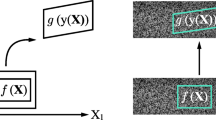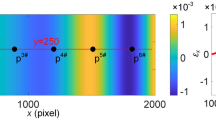Abstract
Background Digital image correlation (DIC) is a widely used experimental method to measure full-field displacements and strains. This technique compares images of speckle patterns before and after deformation to computationally infer the displacement and strain fields. Of particular interest are complex mechanical phenomena where strains are far from uniform.
Objective In such situations, it would be desirable to use an adaptive technique with higher resolution in the regions of rapidly changing strain and lower resolution elsewhere.
Methods This paper builds on the recently proposed augmented Lagrangian digital image correlation (ALDIC) method to incorporate mesh adaptivity. We call the resulting approach adapt-ALDIC.
Results We show that the structure of ALDIC makes it easy to incorporate adaptive resolution. We demonstrate through both synthetic and experimental examples that adapt-ALDIC is robust and saves significant computational time with almost no loss in accuracy. Among two types of adaptive mesh strategies, we find that adaptive quadtree mesh outperforms Kuhn triangulation mesh both in accuracy and computational cost. Indeed, we demonstrate that quadtree adapt-ALDIC provides compatible deformation and noise insensitivity typical of global DIC at the cost of local DIC.
Conclusions Adapt-ALDIC with adaptive quadtree mesh can analyze heterogeneous deformations accurately and efficiently. An open-source Matlab code is freely available through GitHub and Caltech DATA.










Similar content being viewed by others
Notes
We only consider FE-based global DIC in this work. It is also possible to have other basis sets for global DIC, and other approaches like dense global DIC. We do not consider them here.
The introduction of the regularizer requires a boundary condition, and one can proceed analogously with displacement boundary conditions if the boundary displacements are known.
In our previous work on ALDIC [25], we used finite difference discretization where the gradients are defined on the nodes.
References
Sutton MA ,Orteu JJ, Schreier HW (2009) Image correlation for shape, motion and deformation measurements: basic concepts, theory and applications. Springer-Verlag GmbH
Pan B, Qian K, Xie H, Asundi A (2009) Two-dimensional digital image correlation for in-plane displacement and strain measurement: a review. Meas Sci Technol 20:062001
Besnard G, Leclerc H, Hild F, Roux S, Swiergiel N (2012) Analysis of image series through global digital image correlation. J Strain Anal Eng Des 47:214–228
Hild F, Roux S (2008) CorreliQ4: A software for finite element displacement field measurements by digital image correlation. Rapport interne LMT Cachan 269:195
Blaber J, Adair B, Antoniou A (2015) Ncorr: Open-Source 2D Digital Image Correlation Matlab Software. Exp Mech 55:1105–1122
Turner D, Crozier P, and Reu P (2015) Digital Image Correlation Engine (DICe). Sandia Report, SAND2015-10606 O
Belloni V, Ravanelli R, Nascetti A, Di Rita M, Mattei D, Crespi M (2019) py2DIC: A new free and open source software for displacement and strain measurements in the field of experimental mechanics. Sensors 19:3832
Chen Z, Lenthe W, Stinville JC, Echlin M, Pollock TM, Daly S (2018) High-resolution deformation mapping across large fields of view using scanning electronmicroscopy and digital image correlation. Exp Mech 58:1407–1421
Bugra I, Kapan E, Turkoglu O, Aydıner CC (2019) In situ investigation of strain heterogeneity and microstructural shear bands in rolled magnesium AZ31. Int J Plasticity 118:233–251
Shafaghi N, Kapan E, Aydıner CC (2020) Cyclic Strain Heterogeneity and Damage Formation in Rolled Magnesium Via In Situ Microscopic Image Correlation. Exp Mech 60:735–751
Schreier HW, Sutton MA (2002) Systematic errors in digital image correlation due to undermatched subset shape functions. Exp Mech 42:303–310
Wang B, Pan B (2019) Self-adaptive digital volume correlation for unknown deformation fields. Exp Mech 59(2):149–162
Pierré JE, Passieux JC, Périé JN (2017) Finite element stereo digital image correlation: framework and mechanical regularization. Exp Mech 57:443–456
Patel M, Leggett SE, Landauer AK, Wong IY, Franck C (2018) Rapid, topology-based particle tracking for high-resolution measurements of large complex 3D motion fields. Sci Rep 8:5581
Chen Z, Daly S (2018) Deformation twin identification in magnesium through clustering and computer vision. Mater Sci Eng A 736:61–75
Passieux JC, Bugarin F, David C, Périé JN, Robert L (2015) Multiscale displacement field measurement using Digital Image Correlation: Application to the identification of elastic properties. Exp Mech 55:121–137
Tadmor E, Nezzar S, Vese L (2004) A multiscale image representation using hierarchical (BV, \(\cal{L}_{2}\)) decompositions. Multiscal Model Simul 2:554–579
Pan B, Xie HM, Wang ZY, Qian KM, Wang ZY (2008) Study on subset size selection in digital image correlation for speckle patterns. Opt Express 16(10):7037–7048
Yuan Y, Huang YJ, Peng XL, Xiong CY, Fang J, Yuan F (2014) Accurate displacement measurement via a self-adaptive digital image correlation method based on a weighted ZNSSD criterion. Opt Lasers Eng 52:75–85
Zhan Q, Yuan Y, Fan XT, Huang JY, Xiong CY, Yuan F (2016) Digital image correlation involves an inverse problem: A regularization scheme based on subset size constraint. Opt Lasers Eng 81:54–62
Wang B, Pan B (2019) Anisotropic self-adaptive digital volume correlation with optimal cuboid subvolumes. Meas Sci Technol 30(11):115008
Wittevrongel L, Lava P, Lomov SV, Debruyne D (2015) A self adaptive global digital image correlation algorithm. Exp Mech 55:361–378
Yuan Y, Huang JY, Fang J, Yuan F, Xiong CY (2015) A self-adaptive sampling digital image correlation algorithm for accurate displacement measurement. Opt Lasers Eng 65:57–63
Ronovskỳ A, Vašatová A (2017) Elastic image registration based on domain decomposition with mesh adaptation. Mathematical analysis and numerical mathematics 15:322–330
Yang J, Bhattacharya K (2019) Augmented Lagrangian digital image correlation. Exp Mech 59:187–205
Yang J (2019) Augmented Lagrangian Digital Image Correlation Matlab code (2D_ALDIC). Caltech DATA: https://data.caltech.edu/records/1794
Yang J, and Bhattacharya K (2019) Fast adaptive global digital image correlation. In L Lamberti, MT Lin, C Furlong, C Sciammarella, PL. Reu, and MA Sutton, editors, Advancement of Optical Methods & Digital Image Correlation in Experimental Mechanics, Volume 3, pages 69–73. Springer
Xu XH, Su Y, Zhang QC (2017) Theoretical estimation of systematic errors in local deformation measurements using digital image correlation. Opt Lasers Eng 88:265–279
Yang J (2020) Adaptive Mesh Augmented Lagrangian Digital Image Correlation MATLAB code (adapt_ALDIC). Caltech DATA: https://data.caltech.edu
Leclerc H, Périé JN, Hild F, Roux S (2012) Digital volume correlation: what are the limits to the spatial resolution? Mec Ind 13:361–371
Pan B, Wang B, Lubineau G, Moussawi A (2015) Comparison of subset-based local and finite element-based global digital image correlation. Exp Mech 55:887–901
Wang TY, Qian KM (2017) Parallel computing in experimental mechanics and optical measurement: A review (II). Optics and Lasers in Engineering
Bouclier R, Passieux JC (2017) A domain coupling method for finite element digital image correlation with mechanical regularization: Application to multiscale measurements and parallel computing. Int J Numer Methods Eng 111:123–143
Fedele R, Galantucci L, Ciani A (2013) Global 2D digital image correlation for motion estimation in a finite element framework: a variational formulation and a regularized, pyramidal, multi-grid implementation. Int J Number Methods Eng 96:739–762
Horn BK, and Schunck BG (1981) Determining optical flow. In 1981 Technical Symposium East, pages 319–331. International Society for Optics and Photonics
Modersitzki J (2004) Numerical methods for image registration. Oxford University Press on Demand
Christensen GE (1994) Deformable shape models for anatomy
Fischer B, Modersitzki J (2003) Combining landmark and intensity driven registrations. PAMM 3:32–35
Burger M, Modersitzki J, Ruthotto L (2013) A hyperelastic regularization energy for image registration. SIAM J Sci Comput 35:B132–B148
Yang J (2019) Fast adaptive augmented lagrangian digital image correlation. PhD thesis, California Institute of Technology
Glowinski R (2016) ADMM and Non-convex Variational Problems. In: Glowinski R, Osher SJ, Yin W (eds) Splitting Methods in Communication. Imaging, Science and Engineering, Scientific Computation. Springer, Cham, Switzerland, pp 251–299
Boyd S, Parikh N, Chu E, Peleato B, Eckstein J (2010) Distributed optimization and statistical learning via the alternating direction method of multipliers. Mach Learn 3:1–122
Bangerth W, Joshi A (2008) Adaptive finite element methods for the solution of inverse problems in optical tomography. Inverse Prob 24:034011
Nochetto RH, Siebert KG, and Veeser A (2009) Theory of adaptive finite element methods: an introduction. In Multiscale, nonlinear and adaptive approximation, pages 409–542. Springer
Dörfler W, Rumpf M (1998) An adaptive strategy for elliptic problems including a posteriori controlled boundary approximation. Mathematics of Computation of the American Mathematical Society 67:1361–1382
Moore DW (1992) Simplical mesh generation with applications. Technical report, Cornell University
Popinet S (2003) Gerris: a tree-based adaptive solver for the incompressible Euler equations in complex geometries. J Comput Phys 190:572–600
Reddy (1993) An introduction to the finite element method, volume 2. McGraw-Hill New York
Gupta AK (1978) A finite element for transition from a fine to a coarse grid. Int J Numer Methods Eng 12:35–45
Stefan AF, Anja S (2020) Adaptive mesh refinement in 2D: An efficient implementation in Matlab. Computational Methods in Applied Mathematics 20:459–479
Reu PL, Toussaint E, Jones E, Bruck HA, Iadicola M, Balcaen R, Turner DZ, Siebert T, Lava P, Simonsen M (2018) DIC challenge: Developing images and guidelines for evaluating accuracy and resolution of 2D analyses. Exp Mech 58:1067–1099
Saraswathibhatla A, and Notbohm J (2017) Applications of DIC in the mechanics of collective cell migration. In International Digital Imaging Correlation Society, pages 51–53
Saraswathibhatla A, and Notbohm J (2020) Tractions and stress fibers control cell shape and rearrangements in collective cell migration. Phys Rev X 10:011016
Zhang ZY, James RD, Múller S (2009) Energy barriers and hysteresis in martensitic phase transformations. Acta Mater 57:4332–4352
Song YT, Chen X, Dabade V, Shield TW, James RD (2013) Enhanced reversibility and unusual microstructure of a phase-transforming material. Nature 502:85
Stebner AP, Bigelow GS, Yang J, Shukla DP, Saghaian SM, Rogers R, Garg A, Karaca HE, Chumlyakov Y, Bhattacharya K et al (2014) Transformation strains and temperatures of a nickel-titanium-hafnium high temperature shape memory alloy. Acta Mater 76:40–53
Bhattacharya K (2003) Microstructure of martensite: why it forms and how it gives rise to the shape-memory effect, vol 2. Oxford University Press
Yang J, Hazlett L, Landauer AK, Franck C (2020) Augmented lagrangian digital volume correlation. Exp Mech 60:1205–1223
Landauer AK, Patel M, Henann DL, Franck C (2018) A q-factor-based digital image correlation algorithm (qDIC) for resolving finite deformations with degenerate speckle patterns. Exp Mech 58:815–830
Franck C, Hong S, Maskarinec SA, Tirrell DA, Ravichandran G (2007) Three-dimensional full-field measurements of large deformations in soft materials using confocal microscopy and digital volume correlation. Exp Mech 47:427–438
Réthoré J, Hild F, Roux S (2008) Extended digital image correlation with crack shape optimization. Int J Numer Methods Eng 73:248–272
Poissant J, Barthelat F (2010) A novel subset splitting procedure for digital image correlation on discontinuous displacement fields. Exp Mech 50:353–364
Rubino V, Rosakis AJ, Lapusta N (2019) Full-field ultrahigh-speed quantification of dynamic shear ruptures using digital image correlation. Exp Mech 59:551–582
Tal Y, Rubino V, Rosakis AJ, Lapusta N (2019) Enhanced digital image correlation analysis of ruptures with enforced traction continuity conditions across interfaces. Appl Sci 9:1625
Acknowledgements
We are grateful to Prof. Jacob Notbohm and Aashrith Saraswathibhatla who shared their experimental data with us. We gratefully acknowledge the support of the US Air Force Office of Scientific Research through the MURI grant ‘Managing the Mosaic of Microstructure’ (FA9550-12-1-0458).
Author information
Authors and Affiliations
Corresponding author
Ethics declarations
Conflicts of Interest
The authors declare that they have no conflict of interest.
Electronic supplementary material
Below is the link to the electronic supplementary material.
Rights and permissions
About this article
Cite this article
Yang, J., Bhattacharya, K. Fast Adaptive Mesh Augmented Lagrangian Digital Image Correlation. Exp Mech 61, 719–735 (2021). https://doi.org/10.1007/s11340-021-00695-9
Received:
Accepted:
Published:
Issue Date:
DOI: https://doi.org/10.1007/s11340-021-00695-9




